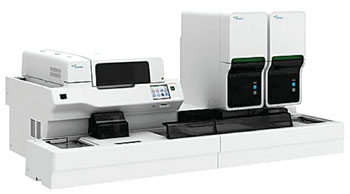Automated Nucleated Red Blood Cell Enumeration Evaluated
|
By LabMedica International staff writers Posted on 17 Jun 2015 |
The enumeration of nucleated red blood cell (NRBC) has been evaluated on a new automated hematology analyzer and to demonstrate the precision compared to manual counts (MC) at the various NRBC values.
The presence of peripheral blood nucleated red blood cell is associated with pathological conditions and leads to the overestimation of white blood cell count in automated hematology analyzers (HA) and therefore, accurate detection and enumeration of NRBCs are important.
Scientists at Mahidol University (Bangkok, Thailand) analyzed clinical blood specimens that were sent from both in- and out-patient departments to a central laboratory at during August 2013 and October 2013. These peripheral blood specimens were collected using dipotassium ethylenediaminetetraacetic acid (EDTA) as an anticoagulant. The residual samples from routine testing with adequate volume for repeated testing were used and were analyzed within two hours of blood collection.
The automated hematology analyzer used was the Sysmex XN-3000 (Sysmex Corporation; Kobe, Japan) which comprises one sampler, two Sysmex XN Modular analyzers, and one Sysmex SP-10 slidemaker/stainer. Blood smears were prepared on the Sysmex SP-10 slidemaker/stainer using Wright-Giemsa reagent. Staff member counted the number of NRBCs per 200 white blood cells (WBCs) using light microscope at × 400 magnification. Included in the study were 234 specimens from 127 patients (54 males and 73 females) with initial reports of NRBCs more than 0.1% by automated hematology analyzer.
In the comparison study between XN and MC, NRBCs ranged from 0% to 612.5%. Regression analysis demonstrated a close accord between the methods. The mean bias of 14.1% with 95% limits of agreement between 48.76% and 76.95% was found. The NRBC counts from XN appeared to be more in accordance with MC when the NRBCs were lower than 200% with the concordance rate of 94.2%.
The authors concluded that the automated NRBC enumeration by XN was precise and could replace the traditional MC, especially for the specimens with NRBCs lower than 200%. This approach may improve laboratory management, especially for laboratories which frequently encounter normoblastemia. It should be noted that MC is a very laborious procedure requiring skilled technical knowledge. The study was published in the June 2015 issue of the International Journal of Laboratory Hematology.
Related Links:
Mahidol University
Sysmex Corporation
The presence of peripheral blood nucleated red blood cell is associated with pathological conditions and leads to the overestimation of white blood cell count in automated hematology analyzers (HA) and therefore, accurate detection and enumeration of NRBCs are important.
Scientists at Mahidol University (Bangkok, Thailand) analyzed clinical blood specimens that were sent from both in- and out-patient departments to a central laboratory at during August 2013 and October 2013. These peripheral blood specimens were collected using dipotassium ethylenediaminetetraacetic acid (EDTA) as an anticoagulant. The residual samples from routine testing with adequate volume for repeated testing were used and were analyzed within two hours of blood collection.
The automated hematology analyzer used was the Sysmex XN-3000 (Sysmex Corporation; Kobe, Japan) which comprises one sampler, two Sysmex XN Modular analyzers, and one Sysmex SP-10 slidemaker/stainer. Blood smears were prepared on the Sysmex SP-10 slidemaker/stainer using Wright-Giemsa reagent. Staff member counted the number of NRBCs per 200 white blood cells (WBCs) using light microscope at × 400 magnification. Included in the study were 234 specimens from 127 patients (54 males and 73 females) with initial reports of NRBCs more than 0.1% by automated hematology analyzer.
In the comparison study between XN and MC, NRBCs ranged from 0% to 612.5%. Regression analysis demonstrated a close accord between the methods. The mean bias of 14.1% with 95% limits of agreement between 48.76% and 76.95% was found. The NRBC counts from XN appeared to be more in accordance with MC when the NRBCs were lower than 200% with the concordance rate of 94.2%.
The authors concluded that the automated NRBC enumeration by XN was precise and could replace the traditional MC, especially for the specimens with NRBCs lower than 200%. This approach may improve laboratory management, especially for laboratories which frequently encounter normoblastemia. It should be noted that MC is a very laborious procedure requiring skilled technical knowledge. The study was published in the June 2015 issue of the International Journal of Laboratory Hematology.
Related Links:
Mahidol University
Sysmex Corporation
Read the full article by registering today, it's FREE! 

Register now for FREE to LabMedica.com and get access to news and events that shape the world of Clinical Laboratory Medicine. 
- Free digital version edition of LabMedica International sent by email on regular basis
- Free print version of LabMedica International magazine (available only outside USA and Canada).
- Free and unlimited access to back issues of LabMedica International in digital format
- Free LabMedica International Newsletter sent every week containing the latest news
- Free breaking news sent via email
- Free access to Events Calendar
- Free access to LinkXpress new product services
- REGISTRATION IS FREE AND EASY!
Sign in: Registered website members
Sign in: Registered magazine subscribers
Latest Hematology News
- MRD Tests Could Predict Survival in Leukemia Patients
- Platelet Activity Blood Test in Middle Age Could Identify Early Alzheimer’s Risk
- Microvesicles Measurement Could Detect Vascular Injury in Sickle Cell Disease Patients
- ADLM’s New Coagulation Testing Guidance to Improve Care for Patients on Blood Thinners
- Viscoelastic Testing Could Improve Treatment of Maternal Hemorrhage
- Pioneering Model Measures Radiation Exposure in Blood for Precise Cancer Treatments
- Platelets Could Improve Early and Minimally Invasive Detection of Cancer
- Portable and Disposable Device Obtains Platelet-Rich Plasma Without Complex Equipment
- Disposable Cartridge-Based Test Delivers Rapid and Accurate CBC Results
- First Point-of-Care Heparin Monitoring Test Provides Results in Under 15 Minutes

- New Scoring System Predicts Risk of Developing Cancer from Common Blood Disorder
- Non-Invasive Prenatal Test for Fetal RhD Status Demonstrates 100% Accuracy
- WBC Count Could Predict Severity of COVID-19 Symptoms
- New Platelet Counting Technology to Help Labs Prevent Diagnosis Errors
- Streamlined Approach to Testing for Heparin-Induced Thrombocytopenia Improves Diagnostic Accuracy
- POC Hemostasis System Could Help Prevent Maternal Deaths
Channels
Clinical Chemistry
view channel
POC Breath Diagnostic System to Detect Pneumonia-Causing Pathogens
Pseudomonas aeruginosa is a major cause of hospital-acquired and ventilator-associated pneumonia, particularly in lung transplant recipients and patients with structural lung disease. Its ability to form... Read more
Online Tool Detects Drug Exposure Directly from Patient Samples
Doctors often rely on patient interviews and medical records to determine what medications a person has taken, but this information is frequently incomplete. People may forget drugs they used, take over-the-counter... Read moreMolecular Diagnostics
view channel
Blood Biomarker Improves Early Brain Injury Prognosis After Cardiac Arrest
After a cardiac arrest, many patients remain unconscious for days, leaving doctors and families facing uncertainty about whether meaningful recovery is possible. Current tools to assess brain damage, including... Read more
Biomarkers Could Identify Patients at High Risk of Severe AKI After Major Surgery
Acute kidney injury is one of the most common and dangerous complications after major surgery, particularly among patients in intensive care. Even mild impairment of kidney function can lead to long-term... Read more
CLIA Test Identifies Head and Neck Cancer Recurrence from Post-Surgical Lymphatic Fluid
While the lymphatic system’s critical role in metastasis has long been recognized, routine access to patient lymph has been elusive. Now, a non-invasive process can access lymph through the collection... Read moreImmunology
view channelBlood Test Could Detect Adverse Immunotherapy Effects
Immune checkpoint inhibitors have transformed cancer treatment, but they can also trigger serious immune-related adverse events that damage healthy organs and may become life-threatening if not detected early.... Read more
Routine Blood Test Can Predict Who Benefits Most from CAR T-Cell Therapy
CAR T-cell therapy has transformed treatment for patients with relapsed or treatment-resistant non-Hodgkin lymphoma, but many patients eventually relapse despite an initial response. Clinicians currently... Read moreMicrobiology
view channel
Blood-Based Diagnostic Method Could Identify Pediatric LRTIs
Lower-respiratory tract infections (LRTIs) are a leading cause of illness and death worldwide, and pneumonia is the leading infectious cause of death in children under five, claiming the lives of over... Read more
Rapid Diagnostic Test Matches Gold Standard for Sepsis Detection
Sepsis kills 11 million people worldwide every year and generates massive healthcare costs. In the USA and Europe alone, sepsis accounts for USD 100 billion in annual hospitalization expenses.... Read moreRapid POC Tuberculosis Test Provides Results Within 15 Minutes
Tuberculosis remains one of the world’s deadliest infectious diseases, and reducing new cases depends on identifying individuals with latent infection before it progresses. Current diagnostic tools often... Read more
Rapid Assay Identifies Bloodstream Infection Pathogens Directly from Patient Samples
Bloodstream infections in sepsis progress quickly and demand rapid, precise diagnosis. Current blood-culture methods often take one to five days to identify the pathogen, leaving clinicians to treat blindly... Read morePathology
view channel
Rapid Low-Cost Tests Can Prevent Child Deaths from Contaminated Medicinal Syrups
Medicinal syrups contaminated with toxic chemicals have caused the deaths of hundreds of children worldwide, exposing a critical gap in how these products are tested before reaching patients.... Read more
Tumor Signals in Saliva and Blood Enable Non-Invasive Monitoring of Head and Neck Cancer
Head and neck cancers are among the most aggressive malignancies worldwide, with nearly 900,000 new cases diagnosed each year. Monitoring these cancers for recurrence or relapse typically relies on tissue... Read more
Common Health Issues Can Influence New Blood Tests for Alzheimer’s Disease
Blood-based tests for Alzheimer’s disease are transforming diagnosis by offering a simpler alternative to spinal taps and brain imaging. However, many people evaluated at memory clinics also live with... Read more
Blood Test Formula Identifies Chronic Liver Disease Patients with Higher Cancer Risk
Chronic liver disease affects millions worldwide and can progress silently to hepatocellular carcinoma (HCC), one of the deadliest cancers globally. While surveillance guidelines exist for patients with... Read moreTechnology
view channel
Machine Learning Models Diagnose ALS Earlier Through Blood Biomarkers
Amyotrophic lateral sclerosis (ALS) is a rapidly progressive neurodegenerative disease that is notoriously difficult to diagnose in its early stages. Early symptoms often overlap with other neurological... Read more
Artificial Intelligence Model Could Accelerate Rare Disease Diagnosis
Identifying which genetic variants actually cause disease remains one of the biggest challenges in genomic medicine. Each person carries tens of thousands of DNA changes, yet only a few meaningfully alter... Read moreIndustry
view channel
BD and Penn Institute Collaborate to Advance Immunotherapy through Flow Cytometry
BD (Becton, Dickinson and Company, Franklin Lakes, NJ, USA) has entered into a strategic collaboration with the Institute for Immunology and Immune Health (I3H, Philadelphia, PA, USA) at the University... Read more






















